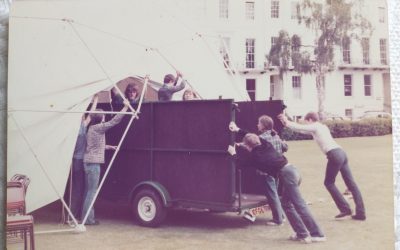I wrote recently about the piano duets played every night at piano camp in France – not just two people at one piano, but sometimes three people at one piano, or four people at two pianos. Famous works of music arranged for multiple hands, with one or two piano keyboards being used to their utmost, and players forced into intriguing proximity.
After all this many-players-at-one-instrument music, I had the opposite experience this week, of seeing one person playing two instruments at once. In this case they were a piano and a bandoneon, the South American concertina which accompanies tango music. Normally the bandoneon requires two hands to play, but the delightfully poker-faced Finnish musician Mikko Helenius – playing with Argentinian singer Martin Alvarado at the Edinburgh Fringe – had found a way to sit at the grand piano, wedging the bandoneon against his right knee such that he could play the piano with his left hand and the bandoneon with his right. Helenius played an unusual solo version of Astor Piazzolla’s beautiful slow piece ‘Oblivion’, the melody on the bandoneon and the rippling harmonies on the piano – quite a feat of co-ordination.
Billy Mayerl, the pianist-composer who was hugely popular in the 1920s and 30s, used to do a music-hall ‘turn’ where he played two pianos at once. Before the advent of YouTube clips, I had always imagined that this must be done by placing the two piano keyboards in a V shape with the pianist sitting in the angle of the V, so as to bring the two instruments as close together as possible. But I learned recently from this clip that Billy had made it even more difficult for himself by having the two piano keyboards face one another, forcing himself to play with hands outstretched to each side. He precedes this portion of the performance by saying chirpily, ‘And here’s a glimpse into the future’. I’m still trying to work out what he meant by that!




And so here is my story,
Born in 1945 My father was a dentist in birmingham. He was an amateur pianist and i emphasise “amateur” He was the worst pianist I ever heard.He played so slowly it drove me mad even at the age of 7. He subscribed to the Billy Mayerl School of Syncopation and recieved all the magazines.No difference he was still awful.As a child I was sent for piano lessons and I hated them but the lady I went to at least the lady taught me to read music. For that I shall be eternally grateful.Fast forward a few years and I discovered the electronic organ. I loved this and took every opportunity to play one. I thought Billy Mayerl and his music was very “old hat”. Post prep school ,public school & university I found myself in Blackpool. (another story) I was in need of a job and Found employment in a small working mens club as resident organist. A baptism of fire ! Play the organ, accompany the cabaret, no rehearsals,go in the dressing room take the music and go out and do it in front of 300 people! I was awful but necessity is the mother of invention. I got better at it, and came to enjoy it. I was young Only 22 and you learn well at that age. Singers are no respectors of keys. D flat G flat and B no longer terrified me.I became a well respected cabaret accompanist. One day in 2004 While ordering some sheet music online from the “music exchange Manchester” a side panel advertised ” Sheet Music For Billy Mayerls Famous Marigold “. Now this took me back to 1958 and my father who told me how difficult this was to play. And on a whim I added it to my order.It duly arrived and I ignored it for a while. Some time later I picked it up and took it too the piano. Cant be that difficult I thought, after all I m the best cabaret organist in Blackpool. Half an hour should see it off.
It took 2 years !
Playing the organ for 40 years is a bad grounding for stride piano. I had to start over again. I knew all the chords but the tenths followed by the chords was a foreign country. (left foot plays the bass on organ). But I persiviered. Year followed year and slowly it all started to come together. Marigold was mastered. Then Hollyhock Then Jazzarhistrix then The Jazz Master (what a B s trd) Mignonette (Teaches u to play in octaves) . Shallow Waters & Evening Primrose then Honky Tonk.
And so the music I thought was “old fashioned” back in 1958 has taught me how to really play the piano in 2014.
His music was really fabulous !!!
Thank you, Philip, for this very interesting story. It illustrates perfectly the challenges and rewards of Billy Mayerl’s piano music!